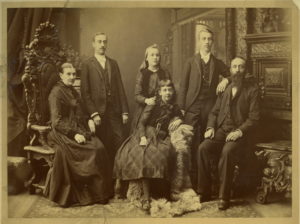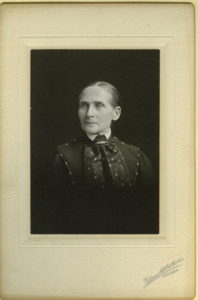The Russell and Oberg families immigrated to the U.S. around the same time:
- The Russells in 1879
- The Obergs (spelled Åberg in the old country of Sweden) in 1887.
The Russell Family

In 1943, Martin Reinhold Wallentin Russell wrote down the story of the name Russell, and related more of the story to the author, his great-grandson. Martin lived to the age of 94 and was affectionately known as “Pops” to his family. Pops wrote that his great-grandmother, born about 1787, married a man named Hanson who died in early adulthood. The couple had three children including their daughter, Martha (Pops’ grandmother), who was born in 1817.
Mrs. Hanson married a second husband, Mr. Russell, who had served in the English army for a time. They had no children, but Martha took the last name Russell. The Russells kept an inn at Hinby, near Malmo, Sweden.
The daughter, Martha Russell, married Andrew Jonsson (1804-1859). The couple had five children; the oldest, Nels Jonsson, was Pops’s father. Nels and his family are pictured above. Nels and his siblings continued as innkeepers at the Inn of Hinby. Their father Andrew had an extensive landholdings around Hinby. He had 8-10 servants to help him till the land. He also rented tracts of land to other farmers who erected their own buildings on the land. Just before his death, Andrew signed a will transferring all of his holdings outside the immediate family, forcing Nels and his four siblings to earn a living in Malmo and vicinity. Why Andrew wrote his children out of his will is a story lost to history.
What we do know is that the five children of Andrew and Martha Jonsson eventually took possession of the inn at Hinby. Whether this was accomplished through skullduggery, bureaucratic sleight of hand, or some more ordinary process is unknown. But ownership of the inn was on record under the name “Russell” and somewhere during the process Nels and his siblings all changed their last names from Jonsson to Russell. Thus, Pops’ father became Nels J. Russell, and today, dozens of descendants of the progenitor Martha Russell Jonsson carry the name Russell as a result of the struggle for control of the Hinby Inn.
The Fate Of The Hinby Inn
No one knows the fate of the inn at Hinby. In 1880, Nels, his his four siblings and their families immigrated to Chicago. Pops’s best recollection is that the family left Sweden due to religious differences with the Swedish State Lutheran Church. Nels was quite religious, and composed many church hymns which survive.
Pops spoke no English when he arrived in the U.S. at the age of 11. He initially worked lighting street lamps in Chicago, a job commonly done by immigrants because it required no English. Eventually he became the treasurer for the American School and Technical Society in Chicago in 1900—a job he held for 40 years.
More About Martin “Pops” Russell

Pops was born in Sweden on February 14, 1868, and is the oldest of Nel’s four children. He was 11 years old when his family immigrated to the U.S. in 1880, settling in Chicago. At about age 12, Martin and his brother, John, had a job lighting street lamps in the city. This job was often done by immigrants, as it required no knowledge of English. Pops worked for a time as an administrator for the Temperance Union. Then, in about 1900, went to work for the American School and Technical Society, where he remained for 40 years as the Treasurer and Board member (a position that would be called Chief Financial Officer today).
The American School was one of two mail-order high school diploma companies in Chicago (the other was the International School). There were no students on site. Pops had a reputation as a tough taskmaster. For example, there were clerks who made entries into the daily ledgers. These entries needed to be added and checked at the end of the day, the ledger books assembled and brought to a safe overnight. the latter task had to be done after 5:00 p.m., as work hours were 9 to 5, and Pops considered these hours to be for “making entries only!”
The Oberg Family

Pops’s mother-in-law, Carolina Anderson was born in Frosvidal, Sweden, in 1839. Her parents were Anders Erson (1804-?) and Maria Catterina (1805-?). We do not know more about them.
Violet Oberg, Martin “Pops” Russell’s second wife, was a granddaughter of Carolina and Carl Oberg. She wrote this about her grandmother:
“Carolina was born on the Estate of Tallhojden, Frosvidal, Parish of Kil, County of Orebro, Province of Nerike, Sweden. According to her testimony, she became a Christian at an early age. In 1856, at the age of seventeen, she left her parents’ home to earn her own living, and served in various homes for about seven years, until 1863 when she came to Frosvidal where Carl Johan Oberg first met her. They became acquainted, fell in love, and married in 1865. Four years later the couple moved to the estate of Hallbytorp in the same parish. In 1887 the family decided to emigrate to America where several children had preceded them.”

Carl and Carolina arrived in Chicago, Illinois, on September 17, 1887. They moved to Morgan Park, where Carl established himself in the shoe business. They had seven children, 5 of whom survived childhood. The eldest was Martin Russell’s wife, Hilda Caroline Oberg, born on August 19, 1864.
Violet continued to write:
“Carolina fell ill on 16 March 1897 (“inflammation of the stomach”), was attended by Dr. Sheldon, and died on 26 Mar 1897 at the age of 57 years.”
After Carolina died, Carl remarried to Carolina’s first cousin, Lovisa Johnson Oberg, who is buried at Carolina’s side at Mt. Greenwood Cemetery in Chicago.
The Flexibility Of Swedish Last Names
This flexibility with last names was not so unusual in Sweden. Until the 1800s, Swedish last names were usually based on the father’s first name.
For example, Agnes’s Oberg ancestors include Lars Jansson (1769-?), so named because his father’s first name was Jan. Lars’s daughter was Christina Larsdotter (1807-1889). The custom changed for the next generation: Christina Larsdotter married Anders Åberg (1811-1868), and their children all kept the father’s last name, later Americanized to Oberg.
The Russell And Oberg Families Unite in Marriage
Martin Russell & Hilda Oberg had 3 children:
- Ethel Francis Russell (1893-1971) m. Arthur Consaul Wickenden (1893-1967)
- Herbert Russell (1895-1912)
- Agnes Martha Caroline Russell (1899-1986) m. Gordon Willson Bonner (1900-1951).
© 2013 W. Mullins
